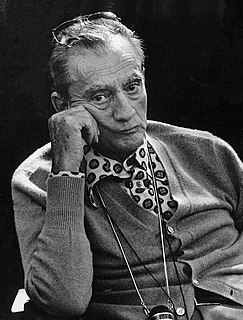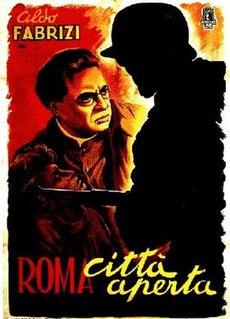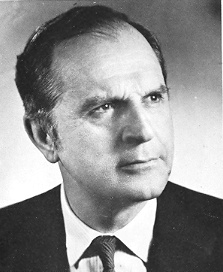Life and work
Renzo Vespignani was born in Rome, Italy in 1924, [1] and he grew up in a Roman working-class suburb named Portonaccio. He began to paint during the difficult years of the German occupation of Rome, hiding himself at Lino Bianchi Barriviera’s residence. [1]
His drawings in 1944 recorded the ravages of German-occupied Rome in realistic detail. [2] Those images, often likened to German Expressionist works, were featured in his first solo exhibition at Rome's Galleria La Margherita in 1945. Meanwhile, he collaborated as a designer with many political-literary reviews done as poetic documentaries, relating to the cinema of Rossellini and Vittorio de Sica. [1]
After the war, Vespignani contributed illustrations to political and literary journals. [1] At New York's Hugo Gallery, his works were introduced to the U.S. in 1948. [2]
In 1956 he co-founded, with other intellectuals, the review Citta Aperta ("City Opened"), a magazine concerning the city culture's problems. [1] At this time, his work had begun to focus on life in the harsh neighborhoods of Rome's periphery, displaying a connection with the films and literature of Italian Neorealism. [2]
In 1963, with the painters, Ferroni, Ennio Calabria, Giuseppe Guerreschi, Piero Guccione, Piero Guccione e Alberto Gianquinto and the art critics Dario Micacchi, Antonio Del Guercio and Morosini, he founded the group Il pro e il Contro (Pro and Con), which immediately became a point of reference for the newborn neo-figures experiments. [1] During the decade of the 1960s, Vespignani and the group sought to develop new critically and intellectually engaged figural art. [2] Vespignani illustrated the works of Boccaccio, Kafka and T. S. Eliot, among others. [2]
Renzo Vespignani exhibited works across Italy and had participated in the Venice Biennale four times. [2] A 1985 exhibition at the French Academy in Rome examined the rapport between Vespignani's work and that of the Neorealist poet and filmmaker Pier Paolo Pasolini. [2]
After the 1970s, Vespignani rarely exhibited abroad, although two bodies of his work from the 1990s, Manhattan Transfer and An Afternoon in Chelsea, had been inspired by visits to New York City. [2]
Renzo Vespignani died on April 26, 2001, while undergoing surgery. [2]

Luchino Visconti di Modrone, Count of Lonate Pozzolo was an Italian filmmaker, stage director, and screenwriter. A major figure of Italian art and culture in the mid-20th century, Visconti was one of the fathers of cinematic neorealism, but later moved towards luxurious, sweeping epics dealing with themes of beauty, decadence, death and European history, especially the decay of the nobility and the bourgeoisie. He was the recipient of many accolades, including the Palme d'Or and the Golden Lion, and many of his works are regarded as highly-influential to future generations of filmmakers.

Italian neorealism, also known as the Golden Age, is a national film movement characterized by stories set amongst the poor and the working class. They are filmed on location, frequently with non-professional actors. They primarily address the difficult economic and moral conditions of post-World War II Italy, representing changes in the Italian psyche and conditions of everyday life, including poverty, oppression, injustice and desperation.

Anna Maria Magnani was an Italian actress. She was known for her explosive acting and earthy, realistic portrayals of characters.

Rome, Open City is a 1945 Italian neorealist war drama film directed by Roberto Rossellini and co-written by Sergio Amidei and Federico Fellini. Set in Rome in 1944, the film follows a diverse group of characters coping under the Nazi occupation, and centers on a Resistance fighter trying to escape the city with the help of a Catholic priest. The title refers to Rome being declared an open city after 14 August 1943. It forms the first third of Rosselini's “Neorealist Trilogy”, followed by Paisan (1946) and Germany, Year Zero (1948).

Pietro Consagra was an Italian sculptor. In 1947 he was among the founding members of the Forma 1 group of artists, who advocated both Marxism and structured abstraction.

My Voyage to Italy is a personal documentary by acclaimed Italian-American director Martin Scorsese. The film is a voyage through Italian cinema history, marking influential films for Scorsese and particularly covering the Italian neorealism period.
In art, neorealism refers to a few movements.

Antonello Trombadori was an Italian politician, art critic and journalist.

Alberto Burri was an Italian visual artist, painter, sculptor, and physician based in Città di Castello. He is associated with the matterism of the European informal art movement and described his style as a polymaterialist. He had connections with Lucio Fontana's spatialism and, with Antoni Tàpies, an influence on the revival of the art of post-war assembly in America as in Europe.

Luigi Zampa was an Italian film director.

Boccaccio '70 is a 1962 comedy anthology film directed by Vittorio De Sica, Federico Fellini, Mario Monicelli and Luchino Visconti from an idea by Cesare Zavattini. It consists of four episodes, each by one of the directors, all about a different aspect of morality and love in modern times in the style of Giovanni Boccaccio.
Francesco Bocchi was an Italian writer of the late Renaissance, active in Florence.
For the 19th-century painter and sculptor, see Pier Celestino Gilardi
Galleria Ca' d'Oro is an international contemporary art gallery curated and organized by Gloria Porcella. The gallery was founded in Rome by Antonio Porcella in 1970, and currently has three locations in Rome, Miami, and New York City.

Michele Valori was an Italian urban designer and architect.
Pasquale Verrusio was an Italian painter, sculptor and engraver.

Giovanni di Piamonte was a 15th-century Italian painter. The date and place of his birth are not known, but his name indicates that he was born in Piamonte near the present-day town of Pontassieve in Tuscany. He trained in the circle of Piero della Francesca and was one of his assistants.

Bruno Caruso was an influential Italian artist, graphic designer and writer who spent much of his adult life working in Rome.
A Ray of Sun (1997) is a biographical film by German filmmaker Georg Brintrup on the life of Roman film music composer Renzo Rossellini and his brother Roberto Rossellini, one of the prominent film directors of the Italian neorealist cinema.

Carlo Salinari was an Italian literary critic and academic.
This page is based on this
Wikipedia article Text is available under the
CC BY-SA 4.0 license; additional terms may apply.
Images, videos and audio are available under their respective licenses.














